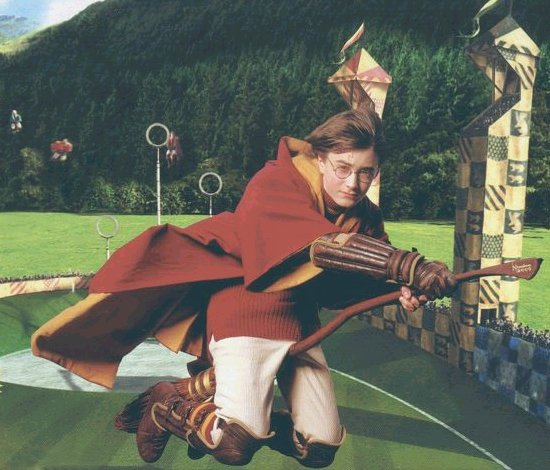Physicist: Using magic? No. But people do try.
There are no physical theories that allow for the existence of magic, as described in Harry Potter™ and or other creative ventures of that ilk. However, if you had an amazing amount of money and energy, you might be able to set up some kind of magnetic system that allowed people, while within the arena, to be propelled around on things the size of broomsticks.
Bill Gates could probably get something set up, but he’s too busy curing malaria or something.
I wish I could say something about how awesome superconductors are, or that they might be useful, but all they’d really be useful for is moving the players around as though they were on tracks. If you really want to control how everything moves around you’d have to use “servo-mechanistic electromagnetic suspension” (that’s a made up phrase, but it is a decent description). This is how maglev trains today work.
Normally, a pair of magnets will either snap together or fly apart. To suspend one magnet above another (without snapping or flying), or move one magnet around in a controlled way, requires the use of one or several tightly controlled electromagnets, that vary their strength very quickly to react to the position of the magnet they’re suspending. This is a “servomechanism“.
It would take stunning buckets of power to create a magnet field the size of an arena, that’s capable of suspending a person (and broom). But the real difficulty is in coming up with a way of targeting 15 separate objects: two teams of 7 players, and the “snitch”. In theory, you could put together some kind of extremely sophisticated array of small coils in the ground and in the stands that could target a magnetic field to relatively small areas in space (person sized). This sort of technique is used for things like “hypersonic sound“, which is a “beam of sound”.
However, there’s a drawback. In order to get a wave phenomena (sound waves, ocean waves, magnetic, whatever) to stay stay confined (like a beam) and not just go wherever, you need the wavelength to be fairly short. A good rule of thumb is that the wavelengths need to be about the size of the region in question or shorter. This is just another incarnation of the uncertainty principle (which is all about waves). At about the same time that you’re using wavelengths short enough to (theoretically) target individual people and brooms, and not all the objects in the arena, you’ll find that your previously gentle magnetic field is now made up of microwaves (microwaves, and light in general, are just high frequency electromagnetic fields).
So, after years of effort and (let’s say) billions of dollars in R&D, you’ll find that what you’ve really made is the most whimsical death machine ever constructed. Real-world Quidditch would a very short, but spectacular game.








Pingback: Top Quidditch Broomstick Models for Wizarding Sport